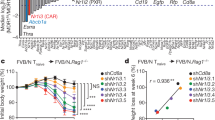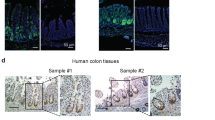Abstract
Toxic compounds such as carcinogens are removed from the body by the action of a series of detoxifying enzymes and transporters expressed in the liver and the small intestine. We have found that intestinal epithelial cells expressing the SV40 large T antigen (TAg) contain significantly lower levels of mRNAs, encoding several drug metabolizing/detoxifying enzymes and transporters compared to their non-transgenic littermates. In addition, TAg blocks the induction of these mRNAs by xenobiotics. The repression depends on an intact LXCXE motif in TAg, suggesting that inactivation of the retinoblastoma (Rb) family of tumor suppressors plays a role in the process. These results imply that a functional Rb pathway in the intestine is necessary for the expression of the detoxification system used to clear carcinogens, and suggest that loss of this tumor suppressor might alter susceptibility to chemical injury. In addition, the effect of TAg on the detoxification pathway appears to be tissue-specific, as its ectopic expression in the liver failed to suppress the P450 enzymes. The TAg-mediated suppression of drug metabolizing/detoxifying enzymes may have broad implications in the metabolism and mechanism of action of both carcinogens and prescription drugs.
This is a preview of subscription content, access via your institution
Access options
Subscribe to this journal
Receive 50 print issues and online access
$259.00 per year
only $5.18 per issue
Buy this article
- Purchase on Springer Link
- Instant access to full article PDF
Prices may be subject to local taxes which are calculated during checkout





Similar content being viewed by others
References
Ahuja D, Saenz-Robles MT, Pipas JM . (2005). SV40 large T antigen targets multiple cellular pathways to elicit cellular transformation. Oncogene 24: 7729–7745.
Bosco EE, Mayhew CN, Hennigan RF, Sage J, Jacks T, Knudsen ES . (2004). RB signaling prevents replication-dependent DNA double-strand breaks following genotoxic insult. Nucleic Acids Res 32: 25–34.
Blumberg B, Sabbagh W, Juguilon H, Bolado Jr J, Ong ES, Evans RM . (1998). SXR, a novel steroid and xenobiotic-sensing nuclear receptor. Genes Dev 12: 3195–3205.
Chandrasekaran C, Coopersmith CM, Gordon JI . (1996). Use of normal and transgenic mice to examine the relationship between terminal differentiation of intestinal epithelial cells and accumulation of their cell cycle regulators. J Biol Chem 271: 28414–28421.
Chrivia JC, Kwok RPS, Lamb N, Hagiwara M, Montminy MR, Goodman RH . (1993). Phosphorylated CREB binds specifically to the nuclear protein CBP. Nature 365: 855–859.
Cohn SM, Simon TC, Roth KA, Birkenmeier EH, Gordon JI . (1992). Use of transgenic mice to map cis-acting elements in the intestinal fatty acid binding protein gene (Fabpi) that control its cell lineage-specific and regional patterns of expression along the duodenal-colonic and crypt-villus axes of the gut epithelium. J Cell Biol 119: 27–44.
DeCaprio JA, Ludlow JW, Figge J, Shew JY, Huang CM, Lee WH et al. (1988). SV40 large tumor antigen forms a specific complex with the product of the retinoblastoma susceptibility gene. Cell 54: 275–283.
Ewen ME, Ludlow JW, Marsilio E, DeCaprio JA, Millikan RC, Cheng SH et al. (1989). An N-terminal transformation-governing sequence of SV40 large T antigen contributes to the binding of both p110Rb and a second cellular protein, p120. Cell 58: 257–267.
Hauft SM, Kim SH, Schmidt GH, Pease S, Rees S, Harris S et al. (1992). Expression of SV-40 T antigen in the small intestinal epithelium of transgenic mice results in proliferative changes in the crypt and reentry of villus-associated enterocytes into the cell cycle but has no apparent effect on cellular differentiation programs and does not cause neoplastic transformation. J Cell Biol 117: 825–839.
Kim RB . (2003). Organic anion-transporting polypeptide (OATP) transporter family and drug disposition. Eur J Clin Invest 33: 1–5.
Kim SH, Roth KA, Coopersmith CM, Pipas JM, Gordon JI . (1994). Expression of wild-type and mutant simian virus 40 large tumor antigens in villus-associated enterocytes of transgenic mice. Proc Natl Acad Sci USA 91: 6914–6918.
Kim SH, Roth KA, Moser AR, Gordon JI . (1993). Transgenic mouse models that explore the multistep hypothesis of intestinal neoplasia. J Cell Biol 123: 877–893.
Kullak-Ublick GA . (2003). ABC transporter regulation by bile acids: where PXR meets FXR. J Hepatol 39: 628–630.
Kliewer SA, Moore JT, Wade L, Staudinger JL, Jones MA, McKee DD et al. (1998). An orphan nuclear receptor activated by pregnanes defines a novel steroid signaling pathway. Cell 92: 73–82.
Liu F, Song YK, Liu D . (1999). Hydrodynamic-based transfection in animals by systemic administration of plasmid DNA. Gene Therapy 6: 1258–1266.
Maurel P . (1996). The CYP3 family. In: Ioannides C (ed). Cytochrome P450: Metabolic and Toxicological Aspects. CRC Press: Boca Raton, FL, pp 241–270.
Mayhew CN, Perkin LM, Zhang X, Sage J, Jacks T, Knudsen ES . (2004). Discrete signaling pathways participate in RB-dependent responses to chemotherapeutic agents. Oncogene 23: 4107–4120.
Mizuno N, Niwa T, Yotsumoto Y, Sugiyama Y . (2003). Impact of drug transporter studies on drug discovery and development. Pharmacol Rev 55: 425–461.
McFadyen MC, McLeod HL, Jackson FC, Melvin WT, Doehmer J, Murray GI . (2001). Cytochrome P450 CYP1B1 protein expression: a novel mechanism of anticancer drug resistance. Biochem Pharmacol 62: 207–212.
Oyama T, Kagawa N, Kunugita N, Kitagawa K, Ogawa M, Yamaguchi T et al. (2004). Expression of cytochrome P450 in tumor tissues and its association with cancer development. Front Biosci 9: 1967–1976.
Puga A, Marlowe J, Barnes S, Chang CY, Maier A, Tan Z et al. (2002). Role of the aryl hydrocarbon receptor in cell cycle regulation. Toxicology 181–182: 171–177.
Renton KW . (2004). Cytochrome P450 regulation and drug biotransformation during inflammation and infection. Curr Drug Metab 5: 235–243.
Rodriguez-Antona C, Ingelman-Sundberg M . (2006). Cytochrome P450 pharmacogenetics and cancer. Oncogene 26: 1679–1691.
Rooseboom M, Commandeur JN, Vermeulen NP . (2004). Enzyme-catalyzed activation of anticancer prodrugs. Pharmacol Rev 56: 53–102.
Saini SP, Mu Y, Gong H, Toma D, Uppal H, Ren S et al. (2005). Dual role of orphan nuclear receptor pregnane X receptor in bilirubin detoxification in mice. Hepatology 41: 497–505.
Srinivasan A, McClellan AJ, Vartikar J, Marks I, Cantalupo P, Li Y, Whyte P et al. (1997). The amino-terminal transforming region of simian virus 40 large T and small T antigens functions as a J domain. Mol Cell Biol 17: 4761–4773.
Sompayrac L . (1997). SV40 and adenovirus may act as cocarcinogens by downregulating glutathione S-transferase expression. Virology 233: 130–135.
Uppal H, Toma D, Saini SPS, Ren S, Jones TJ, Xie W . (2005). Combined loss of orphan receptors PXR and CAR heightens the sensitivity to toxic bile acids in mice. Hepatology 41: 168–176.
Williams JA, Hyland R, Jones BC, Smith DA, Hurst S, Goosen TC et al. (2004). Drug–drug interactions for UDP-glucuronosyltransferase substrates: a pharmacokinetic explanation for typically observed low exposure (AUCi/AUC) ratios. Drug Metab Dispos 32: 1201–1208.
Xie W, Barwick JL, Simon CM, Downes M, Blumberg B, Neuschwander-Tetri BA et al. (2000). Humanized xenobiotic response in mice expressing nuclear receptor SXR. Nature 406: 435–439.
Xie W, Uppal H, Saini SPS, Mu Y, Little JM, Radominska-Pandya A et al. (2004). Orphan nuclear receptor-mediated xenobiotic regulation in drug metabolism and human diseases. Drug Discov 9: 442–449.
Acknowledgements
We thank Ying Mu for his help in transfection studies. This work was supported by NIH Grants CA40586 and CA098956 to JMP and ES012479 and CA107011 to WX. HG is supported by a Susan G Komen Breast Cancer Foundation Postdoctoral Fellowship (PDF053458).
Author information
Authors and Affiliations
Corresponding authors
Additional information
Supplementary Information accompanies the paper on the Oncogene website (http://www.nature.com/onc).
Supplementary information
Rights and permissions
About this article
Cite this article
Sáenz-Robles, M., Toma, D., Cantalupo, P. et al. Repression of intestinal drug metabolizing enzymes by the SV40 large T antigen. Oncogene 26, 5124–5131 (2007). https://doi.org/10.1038/sj.onc.1210310
Received:
Revised:
Accepted:
Published:
Issue Date:
DOI: https://doi.org/10.1038/sj.onc.1210310



